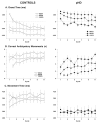Implicit and explicit aspects of sequence learning in pre-symptomatic Huntington's disease
- PMID: 18316233
- PMCID: PMC2562166
- DOI: 10.1016/j.parkreldis.2007.11.009
Implicit and explicit aspects of sequence learning in pre-symptomatic Huntington's disease
Abstract
Learning deficits may be part of the early symptoms of Huntington's disease (HD). Here we characterized implicit and explicit aspects of sequence learning in 11 pre-symptomatic HD gene carriers (pHD) and 11 normal controls. Subjects moved a cursor on a digitizing tablet and performed the following tasks: SEQ: learning to anticipate the appearance of a target sequence in two blocks; VSEQ: learning a sequence by attending to the display without moving for one block, and by moving to the sequence in a successive block (VSEQ test). Explicit learning was measured with declarative scores and number of anticipatory movements. Implicit learning was measured as a strategy change reflected in movement time. By the end of SEQ, pHD had a significantly lower number of correct anticipatory movements and lower declarative scores than controls, while in VSEQ and VSEQ test these indices improved. During all three tasks, movement time changed in controls, but not in pHD. These results suggest that both explicit and implicit aspects of sequence learning may be impaired before the onset of motor symptoms. However, when attentional demands decrease, explicit, but not implicit, learning may improve.
Figures



References
-
- Kirkwood SC, Siemers E, Stout JC, Hodes ME, Conneally PM, Christian JC, et al. Longitudinal cognitive and motor changes among presymptomatic Huntington disease gene carriers. Arch Neurol. 1999;56:563–68. - PubMed
-
- Josiassen RC, Curry L, Roemer RA, DeBease C, Mancall EL. Patterns of intellectual deficit in Huntington's disease. J Clin Neuropsychol. 1982;4:173–83. - PubMed
-
- Taylor HG, Hansotia P. Neuropsychological testing of Huntington's patients. Clues to progression. J Nerv Mental Dis. 1983;171:492–96. - PubMed
-
- Brandt J, Butters N. The neuropsychology of Huntington's disease. Trends Neurol Sci. 1986;9:118–20.
-
- Folstein SE. Huntington's disease a disorder of families. Baltimore: Johns Hopkins University Press; 1989.
Publication types
MeSH terms
Grants and funding
LinkOut - more resources
Full Text Sources
Medical

